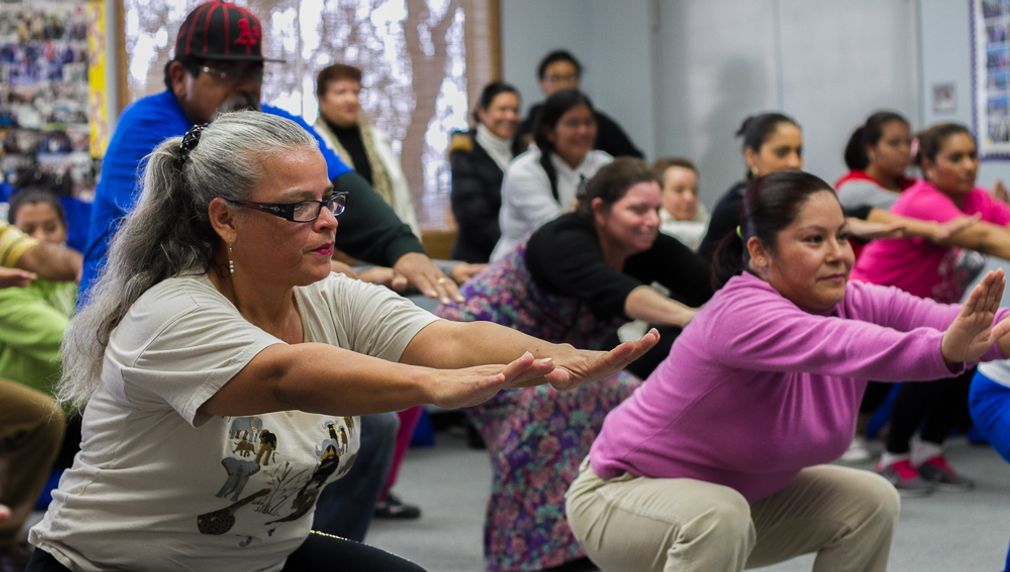Training LA's Low-wage Workers for Healthy Communities
BSP will expand existing training and education programs for low-income, immigrant janitors to build healthy lives for themselves, their families, and the environment. BSP uses a comprehensive approach to address janitors’ specific occupational health concerns and gives families the tools to create healthy lifestyles. At the same time, green workforce development trainings help janitors improve health by accessing better jobs and reduce the carbon footprint of LA’s large commercial buildings.

Briefly tell us a story that demonstrates how your organization turns inspiration into impact.
BSP was founded in 2007 by Executive Director Aida Cardenas, a daughter of property service workers who immigrated to California from Mexico. Our staff are all bilingual in English and Spanish, over 90% are Latino, and most are immigrants or children of immigrants. BSP began with its flagship Vocational ESL course and quickly expanded beyond workforce development to include comprehensive immigrant integration and community development initiatives. BSP now serves over 5,000 workers per year with education and training in vocational and general ESL, sustainable janitorial practices trainings, digital skills, health and wellness, citizenship, parent engagement, financial education, and other areas tailored to the diverse needs of our community.
An example of BSP’s impact can be found in the story of Casilda De Jesus, who graduated from the GJEP program. De Jesus recalled coworkers sneaking Ajax to the worksite until they were discovered by supervisors. “Having a better understanding of green concepts helps janitors buy into green practices”, De Jesus said through an interpreter. The use of cleaning products that have a recognized environmental seal helps buildings receive points toward their LEED certification. De Jesus claims the switch to green cleaning detergents has alleviated her asthma symptoms. Furthermore, De Jesus and other janitors have brought what they learned home about composting, energy and water conservation. De Jesus now unplugs her TV, radio and other appliances when she’s not using them, recognizing that as, “energy vampires,” they are still draining power. She urges her neighbors to report water leaks to their apartment manager.
Which of the LIVE metrics will your submission impact?
Exposure to air toxins
Healthcare access
Obesity rates
In which areas of Los Angeles will you be directly working?
County of Los Angeles
City of Los Angeles
How will your project make LA the best place to LIVE?
BSP’s Health & Wellness Program originated from low health insurance utilization noticing workers’ lack of knowledge on service navigation. The comprehensive, linguistically and culturally competent program emphasizes prevention of prevalent diseases in the community such as diabetes and obesity, and stresses the importance of preventive care. Activities include: Worksite Health Classes, Case Management, Fitness Activities and Health Fairs.
BSP’s Green Janitor Education Program (GJEP) is implemented through collaboration with the U.S. Green Building Council and BOMA-LA, and addresses operations and maintenance practices that enable commercial office buildings meet green performance standards while defining skills, training, and upward career ladder opportunities for workers. The program covers energy efficiency, recycling, waste management, and water conservation.
Among BSP’s service population, 97% are Latin American immigrants, 70% lack basic English proficiency, less than 35% graduated high school, and with an average annual salary of $32,000, workers struggle to keep their families out of poverty. Additionally, 50% are over the age of 50, over 70% are women, and 63% of females are heads of household. Janitors have respiratory and dermatologic issues from exposure to cleaning agents, wet work, and rubber latex. They also suffer from musculoskeletal disorders resulting from awkward postures and prolonged standing, as well as mental health issues resulting from low potential for promotion, work isolation, and irregular/insufficient sleep schedules.
Timeline:
Quarter 1:
-Conduct outreach for Health & Wellness and GJEP
-Schedule training dates
Quarters 2 to 7:
-Conduct at least one Health & Wellness session and one GJEP session per quarter
-Conduct pre/post evaluations to assess student knowledge gains
-Continue outreach and scheduling activities
Quarter 8
-Conduct at least one Health & Wellness session and one GJEP session and final evaluations
-Analyze evaluation data and report on outcomes to stakeholders
As a result of the Health & Wellness program, janitors will have improved English language medical vocabulary, including healthcare terminology and nutrition labels. The will also have an improved ability to converse with medical practitioners. Janitors will learn how to stay healthy at work through eating healthy snacks and moderating caffeine and soft drink consumption; they will also have improved sleep schedules and reduced stress. Moreover, janitors will have improved access to online healthcare resources.
A 2017 study found that 76% of GJEP buildings saw a decrease in energy and water usage, with GJEP buildings using 5.6% less energy on average. Furthermore, while standard cleaning products contain dangerous chemicals, green cleaning products keep janitors safer from respiratory and dermatological disease. Green cleaning products improve indoor air quality for janitors as well as building tenants.
In what stage of innovation is this project?
Expand existing program (expanding and continuing ongoing successful projects)
Please explain how you will define and measure success for your project.
BSP’s programs are designed to improve the quality of life for low-wage, immigrant janitors and their families. BSP recognizes the importance of collecting qualitative and quantitative data as well as following up with participants in order to measure the success of its programs. BSP uses this data to evaluate program success and make improvements for future replication. Sign-in sheets filled out upon entry of each workshop track the number of participants who attend as well as basic demographic and contact information for each individual. Furthermore, surveys conducted before, during, and after trainings measure the effectiveness of the services in relation to participant satisfaction, they measure gains in personal benefits for participants and their families, and they provide the opportunity for participants to give feedback.